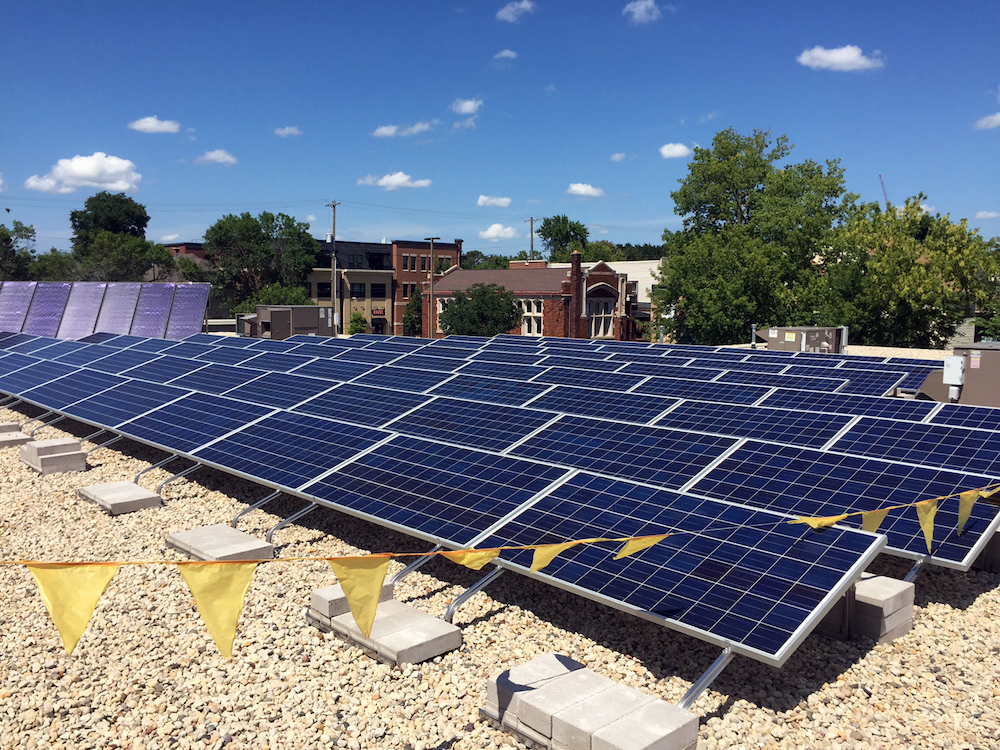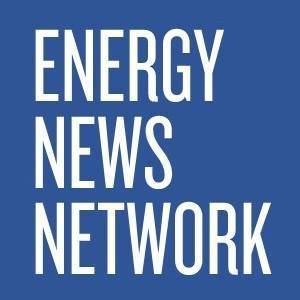Third Party Solar Deals Growing
Helps finance solar panels, despite legal uncertainty in Wisconsin.

A solar installation at the Willy Street Co-op grocery store in Madison, Wisconsin. Photo from the Willy Street Co-op.
The Willy Street Co-op natural foods grocery store in Madison is a place where some people come three times a day to eat, shop or just hang out listening to musicians who play outside. The co-op’s mission is to be environmentally and socially sustainable, so generating power with rooftop solar was a no-brainer.
But after the cooperative’s small solar installation was damaged during a storm three years ago, members worried about how they would afford a new array.
They were considering opening a new store at the time, reducing their available capital. And as a nonprofit institution, they would not be able to take advantage of the federal Investment Tax Credit.
A structure known as third-party ownership, however, made it possible for Willy Street to install a new, larger solar array — a 25-kilowatt installation that went up in spring 2016.
In Wisconsin, there has been uncertainty over whether third-party arrangements are allowed, especially since the utility We Energies tried unsuccessfully to ban them during a 2014 rate case. Some utilities around the country have argued that under third-party arrangements, the owner of the solar array is functioning as a de facto utility selling power to the property owner or host.
Clean energy advocates, including the Chicago-based Environmental Law & Policy Center, have called for clarity on third-party ownership in Wisconsin, possibly in the form of a statement by the Public Service Commission, legislation or a court decision.
Meanwhile even without such an official verdict, third-party arrangements are becoming more common and playing an important role in Wisconsin’s nascent solar boom, according to experts including RENEW Wisconsin program and policy director Michael Vickerman.
“For years we thought we needed some policy clarification to make third-party financing happen in Wisconsin,” said Vickerman. “But today it is proceeding without policy clarification, at least in certain market segments like nonprofit commercial entities.”
He added that “if we had more tightly defined rules, we would have more national market actors operating here. However, a few local developers have devised contract models that enable third party-financed solar projects to go through without challenges.”
Willy Street story
The Willy Street Co-op’s new installation was overseen and installed by the Legacy Solar Wisconsin Cooperative. It was paid for by an anonymous “angel donor,” who was able to reap the tax credit, along with some investment from the co-op and “Slice-of-Sun Solar Bonds” offered by Legacy Solar Co-op and purchased by Willy Street members and others.
The bonds offer buyers a 3 to 5 percent return each year, drawing from the money the co-op would otherwise have had to pay the utility for electricity. And after seven years the bonds can be cashed in, rolled into a 25-year bond or donated to a nonprofit.
After six years, the cooperative can buy the solar array for the net price once the tax credit is subtracted.
Willy Street Co-op finance director Paige Wickline said this situation has been ideal, allowing them to install solar much sooner and more easily than they could have if they had to pay all the money up-front, and without the tax credit. She said the co-op faced no opposition from the local utility, Madison Gas & Electric.
Wickline said the cooperative is hoping to install solar with the aid of third-party ownership at its two other locations. The cooperative rents those spaces, but she said the landlords have been supportive.
“This was exciting because we’re a co-op and we like to work with other cooperatives, and this allowed owners of our cooperative to get involved because they had the opportunity to purchase bonds,” she said. “We got to do a solar project without a huge capital outlay, and we will be able to buy the equipment in the future. So it benefits us, it benefits the investor, it benefits our owners, it benefits the environment.”
Legacy Solar Co-op managing director Kurt Reinhold prefers to call arrangements like Willy Street’s “tax financing” rather than third-party ownership, since there are actually multiple owners of the array.
“There’s a perception that [third-party ownership] is very controversial,” Reinhold said. “But it depends who is this third party. If you’ve got a community institution like a church, library or school, now you have an affinity group that helps support the organization and it’s from that affinity group that we basically crowd-fund solar projects” — through bond sales — while an entity that can access the tax break is also an owner.
Legal situation
If a utility wanted to block a third-party arrangement, the utility could refuse to interconnect the installation to its grid or otherwise challenge it. This could spark a legal case that could lead to a judge deciding on the legality of third-party ownership.
In Iowa in 2014, the solar developer and third-party owner Eagle Point won a major legal victory after the utility Alliant challenged its right to do third-party ownership of an array atop a Dubuque municipal building. The state Supreme Court ruled in Eagle Point’s favor.
“If they lose, they lose everything,” and any ruling would “apply with equal force to all the electric utilities here,” Vickerman said.
He added that there are ways to avoid any appearance that the third-party owner is acting as a utility. For one thing, the property owner or host can pay the same rate to the third-party owner each month, regardless of the amount of solar energy generated. In that case, it would be hard to argue that the third party is selling electricity as a utility would do. Property owners can also invest some capital upfront and co-own the installation along with the investor who is accessing the tax break.
“The current regulatory environment in Wisconsin forces parties to be very careful in designing and executing these forms of arrangements with particular emphasis on avoiding what [Wisconsin statute] refers to as a public utility,” said Reinhold. “We have used several different layers of co-ownership.”
Good for everyone
The T.B. Scott Free Library in Merrill, Wisconsin recently installed a 27-kW solar array with a third-party arrangement with North Wind Renewable Energy. And the Union Cab cooperative company in Madison has also installed solar with Legacy Solar Co-op and third-party or tax financing structures.
Along with municipal buildings, nonprofit cooperatives, churches, schools and hospitals, Native American tribes which pay no taxes are also increasingly looking to third-party ownership. In Wisconsin, the Sokaogon Chippewa Community and Oneida are using third-party financing arrangements with the developer Sunvest Solar for hundreds of kilowatts of solar on various tribal buildings.
Even people or institutions that do pay taxes may need help accessing the federal tax break, if their incomes are low enough or they are covered by government programs — for example, for farmers — that reduce or eliminate their tax burden.
The Investment Tax Credit is scheduled to ramp down and end by 2021. But even if no other tax incentive takes its place, third-party ownership makes solar much more accessible by providing the up-front capital and shouldering the risk of installing solar, as many see it.
Vickerman described it as a win-win situation, where the investor (or solar array owner) “is making money through repayments every month, and after year seven they will have received what they put in plus a return. And why would a customer enter into this arrangement? Because the cost of a solar system [up front] is reduced to essentially zero.”
A version of this story was originally published by Midwest Energy News.





















